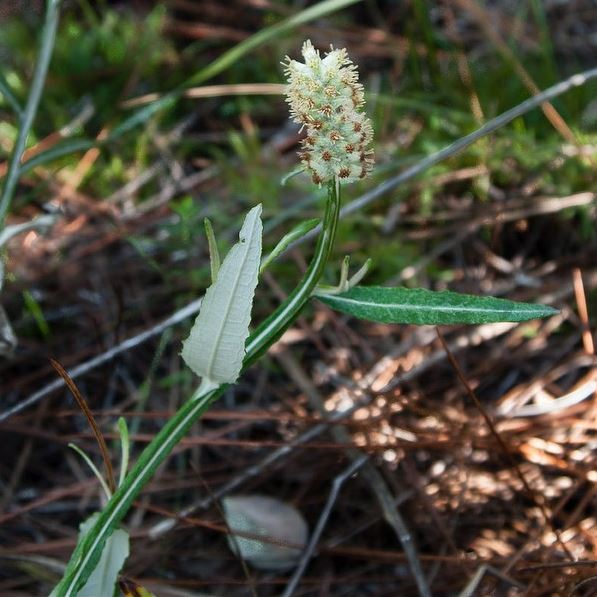Difference between revisions of "Pterocaulon pycnostachyum"
(→Ecology) |
(→Ecology) |
||
| Line 33: | Line 33: | ||
Natural habitats for the ''P. pycnostachyum'' include sandhillas, dry pinelands, and pine flatwoods. <ref name= "Weakley"> Weakley, A. S. (2015). Flora of the Southern and Mid-Atlantic States. Chapel Hill, NC, University of North Carolina Herbarium.</ref> | Natural habitats for the ''P. pycnostachyum'' include sandhillas, dry pinelands, and pine flatwoods. <ref name= "Weakley"> Weakley, A. S. (2015). Flora of the Southern and Mid-Atlantic States. Chapel Hill, NC, University of North Carolina Herbarium.</ref> | ||
| − | ''Pterocaulon pycnostachyum'' can be found in the same habitats as ''Deeringothamnus rugelii'', ''Asclepias pedicellata'', ''Aristida beyrichiana'', ''Asimina reticulata'', ''Cuthbertia ornata'', ''Galactia elliotti'', ''Lygodesmia aphylla'', and '' Pinus palustris''. <ref name= "Canfield" | + | ''Pterocaulon pycnostachyum'' can be found in the same habitats as ''Deeringothamnus rugelii'', ''Asclepias pedicellata'', ''Aristida beyrichiana'', ''Asimina reticulata'', ''Cuthbertia ornata'', ''Galactia elliotti'', ''Lygodesmia aphylla'', and '' Pinus palustris''. <ref name= "Canfield"> [Canfield, S. L. and G. W. Tanner (1997). "Observations of pinywoods dropseed (Sporobolus junceus) phenological development following fire in a sandhill community." Florida Scientist 60(2): 69-72.]</ref> |
<!--Natural communities, human disturbed habitats, topography, hydrology, soils, light, fire regime requirements for removal of competition, etc.--> | <!--Natural communities, human disturbed habitats, topography, hydrology, soils, light, fire regime requirements for removal of competition, etc.--> | ||
===Phenology=== | ===Phenology=== | ||
Revision as of 16:03, 24 May 2018
| Pterocaulon pycnostachyum | |
|---|---|

| |
| Photo by John Bradford hosted at Bluemelon.com/poaceae | |
| Scientific classification | |
| Kingdom: | Plantae |
| Division: | Magnoliophyta - Flowering plants |
| Class: | Magnoliopsida - Dicots |
| Order: | Asterales |
| Family: | Asteraceae |
| Genus: | Pterocaulon |
| Species: | P. pyconstachyum |
| Binomial name | |
| Pterocaulon pycnostachyum (Michx.) Elliot | |

| |
| Natural range of Pterocaulon pycnostachyum from USDA NRCS Plants Database. | |
Contents
Taxonomic Notes
Synonym: P. undulatum (Walter) C. Mohr
Variety: none
Description
P. pycnostachyum is a perennial forb/subshrub of the Asteraceae family that is native to North America. [1]
Distribution
P. pycnostachyum is found in Florida, Georgia, South Carolina, North Carolina, Alabama, and Mississippi in the eastern United States. [1]
Ecology
Habitat
Natural habitats for the P. pycnostachyum include sandhillas, dry pinelands, and pine flatwoods. [2]
Pterocaulon pycnostachyum can be found in the same habitats as Deeringothamnus rugelii, Asclepias pedicellata, Aristida beyrichiana, Asimina reticulata, Cuthbertia ornata, Galactia elliotti, Lygodesmia aphylla, and Pinus palustris. [3]
Phenology
Flowering occurs in June. [4]
Conservation and Management
Cultivation and restoration
Photo Gallery
References and notes
- ↑ 1.0 1.1 USDA Plant Database
- ↑ Weakley, A. S. (2015). Flora of the Southern and Mid-Atlantic States. Chapel Hill, NC, University of North Carolina Herbarium.
- ↑ [Canfield, S. L. and G. W. Tanner (1997). "Observations of pinywoods dropseed (Sporobolus junceus) phenological development following fire in a sandhill community." Florida Scientist 60(2): 69-72.]
- ↑ Pan Flora